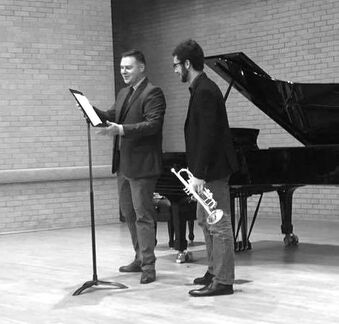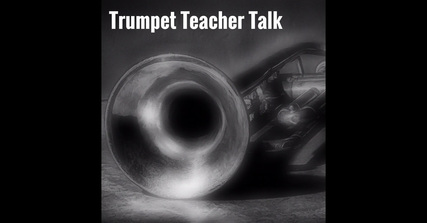PEYDEN SHELTON
Teaching Philosophy and Approach

Music is an art form that tells a story. One that enables an individual to present an idea that they may struggle to express through words, and through which they might find greater confidence through a sense of safety and comfort that other forms of expression do not offer. Musical expression has helped composers and performers throughout history tell stories or share ideas of revolution, secret love, deep loss, and tremendous joys. The same still applies today. In my role as an applied lessons faculty member, my responsibility is to enable students to find their musical voice through the voice of the trumpet through the medium of solo trumpet, small chamber ensembles, and larger performance opportunities. This musical journey may be easy for many, but others often find it difficult to truly connect with this ‘new’ voice and find a true reflection of themselves through the playing of their instrument. In this explorative process, my role as a teacher is to create a safe space for expression in a setting that can often make students feel vulnerable when freely expressing themselves. I enable students to find comfort through small performance exercises which allow them to explore this expression in short micro-performances. These scaffolding exercises, over time, increase in length to ultimately simulate performances of many works across diverse repertoire. Additionally, I spend time connecting with my students on subjects beyond our instrument. This allows them opportunities to share stories, frustrations, excitement, and even complaints about their student experience both in and outside the School of Music. I feel that this consistent part of our weekly interactions enables them to feel a stronger sense of belonging, understand that they are worth a great deal more than what they are able to play, and be more connected to me and to the experiences that we explore within my classroom. These interactions help to make sure students feel at ease and safe within my teaching space when expressing their musical ideas through their instrument as well as helping to establish a personal connection with every student.
This level of comfort and safety in expression enables tremendous growth within a student’s musical performance. However, the performance world beyond our program’s doors has changed drastically since my time at the University of Utah and continues to rapidly change in the aftermath of the Covid-19 Pandemic. Students entering the professional world are being asked to perform repertoire and styles beyond what has typically been a part of the standard curriculum in music programs across the country. My work within my applied lesson studio is to create learning experiences and provide exposure to many of these developments within the professional world. One element of change in the musical world since the Pandemic has been how musical artists showcase their work and market themselves to a new generation of audiences. Much of the necessary skills that are now needed involve video creation and recording skills. As such, I work with students to create edited videos of pieces they have been working on throughout the semester to post to their own YouTube channels. I also teach them how to use many of the Digital Audio Workspaces (DAWs) and microphones to help them create high quality recordings. These skills, in addition to my students’ musical abilities on their instruments, are crucial to their ability to find employment and performance opportunities in a rapidly changing musical landscape. Self- promotion and exposure through digital mediums have become a crucial part of the path to contracting and freelance work outside of major metropolitan areas. This addition to my curriculum is personalized to the individual strengths and struggles of each student. This customization has helped every one of my graduates find employment within the first year of their graduation.
One of the primary areas of my own research is to highlight, through performance and recording, new and rediscovered solo repertoire for trumpet. This enables new, overlooked, and unique voices to be amplified within the corpus of trumpet repertoire. I work closely with my students to foster this same curiosity. Through my curriculum, each student is required to incorporate a newly composed work or music from an underrepresented composer on each of their degree recitals. This allows for every student to understand the process for the creation of new art or to highlight the path in which students can find previously written works for their performances. Having this necessary step in recital and performance planning cultivates a natural curiosity for diverse programming to help amplify these compositional voices of often non-white, non-cis-male composers. Along with this cultivation of new repertoire, I encourage students to take on unique performance opportunities within their applied lessons and chamber ensemble experiences as well. This assortment of musical settings allows students to explore new and unique performance styles, repertoire combinations, and even extended techniques that are beginning to become a common practice within the larger professional performance world. Their expansion of repertoire and adaptability within the performance world helps to provide a greater marketability and confidence in their own professional settings.
Above all other goals as a teacher, my philosophy is centered on the cultivation of a lifelong love of music within each student. This effort enables an enduring adoration of the arts and cultivates future generations of music educators and patrons. When students are excited about what they are studying and contributing to their field, there is a stronger connection to the nuances within the output of their research. This leads to deeper pedagogical conversations during applied lessons and refinement in their personal practice sessions. Each student grows and learns at different rates and through different methods. These variations in learning styles allow me to explore different teaching avenues to teach a singular topic. As students learn through different mediums, I customize my teaching style to how each student best learns and work with them to find consistent progress in their musical and technical growth. This means that I must either provide a strong aural and visual example or explain the process with incredible technical precision, depending on which method most suits the student in question. Once the student grasps the information fully, I can then demonstrate the other method, thereby exposing the student to both methods and giving them a wider understanding of the concept. This helps to elevate our graduates to higher levels of teaching and performing – which in turn helps to cultivate future generations of music performers, educators, and patrons.
*Jean-Baptist Arban's "Complete Conservatory Method for Trumpet" - Free PDF Download
*Herbert L. Clarke's "Technical Studies for the Cornet" - Free PDF Download
Edwin F. Goldman's "Practical Studies for the Trumpet"
*Marco Bordogni (Arr. Mark Tezak) "Melodious Etudes Vol. 1:Trumpet Part"
*Max Schlossberg "Daily Drills and Technical Studies for Trumpet"
*Bai Lin "Lip Flexibilities for All Brass Instruments"
Anthony Plog "Method for Trumpet" (Book 1-7)
*Theo Charlier "36 Transcendental Etudes for Trumpet, Cornet, or Bugle in Bb" - Free PDF Download
Allen Vizzutti "Trumpet Method" (Book 1-3)
Vassily Brandt "34 Orchestral Etudes for Trumpet"
*James Stamp "Warm-Ups and Studies"
Earl D. Irons "27 Groups of Exercises"
*Giuseppe Concone "Lyrical Studies for Trumpet"
These are just a sampling of method and etude books that are available. Please know that each book and exercise can be used to address multiple issues on the trumpet - so be open to trying different books and approaches to fix issues in your own playing. Every person is different in the way they learn and grow. We as teachers must be aware of that and be able to adjust and adapt to a style that works with any individual.
* -Indicates books that are typically required for purchase at the collegiate level. Each studio is different, and please be sure to check your schools requirements and syllabi.
This level of comfort and safety in expression enables tremendous growth within a student’s musical performance. However, the performance world beyond our program’s doors has changed drastically since my time at the University of Utah and continues to rapidly change in the aftermath of the Covid-19 Pandemic. Students entering the professional world are being asked to perform repertoire and styles beyond what has typically been a part of the standard curriculum in music programs across the country. My work within my applied lesson studio is to create learning experiences and provide exposure to many of these developments within the professional world. One element of change in the musical world since the Pandemic has been how musical artists showcase their work and market themselves to a new generation of audiences. Much of the necessary skills that are now needed involve video creation and recording skills. As such, I work with students to create edited videos of pieces they have been working on throughout the semester to post to their own YouTube channels. I also teach them how to use many of the Digital Audio Workspaces (DAWs) and microphones to help them create high quality recordings. These skills, in addition to my students’ musical abilities on their instruments, are crucial to their ability to find employment and performance opportunities in a rapidly changing musical landscape. Self- promotion and exposure through digital mediums have become a crucial part of the path to contracting and freelance work outside of major metropolitan areas. This addition to my curriculum is personalized to the individual strengths and struggles of each student. This customization has helped every one of my graduates find employment within the first year of their graduation.
One of the primary areas of my own research is to highlight, through performance and recording, new and rediscovered solo repertoire for trumpet. This enables new, overlooked, and unique voices to be amplified within the corpus of trumpet repertoire. I work closely with my students to foster this same curiosity. Through my curriculum, each student is required to incorporate a newly composed work or music from an underrepresented composer on each of their degree recitals. This allows for every student to understand the process for the creation of new art or to highlight the path in which students can find previously written works for their performances. Having this necessary step in recital and performance planning cultivates a natural curiosity for diverse programming to help amplify these compositional voices of often non-white, non-cis-male composers. Along with this cultivation of new repertoire, I encourage students to take on unique performance opportunities within their applied lessons and chamber ensemble experiences as well. This assortment of musical settings allows students to explore new and unique performance styles, repertoire combinations, and even extended techniques that are beginning to become a common practice within the larger professional performance world. Their expansion of repertoire and adaptability within the performance world helps to provide a greater marketability and confidence in their own professional settings.
Above all other goals as a teacher, my philosophy is centered on the cultivation of a lifelong love of music within each student. This effort enables an enduring adoration of the arts and cultivates future generations of music educators and patrons. When students are excited about what they are studying and contributing to their field, there is a stronger connection to the nuances within the output of their research. This leads to deeper pedagogical conversations during applied lessons and refinement in their personal practice sessions. Each student grows and learns at different rates and through different methods. These variations in learning styles allow me to explore different teaching avenues to teach a singular topic. As students learn through different mediums, I customize my teaching style to how each student best learns and work with them to find consistent progress in their musical and technical growth. This means that I must either provide a strong aural and visual example or explain the process with incredible technical precision, depending on which method most suits the student in question. Once the student grasps the information fully, I can then demonstrate the other method, thereby exposing the student to both methods and giving them a wider understanding of the concept. This helps to elevate our graduates to higher levels of teaching and performing – which in turn helps to cultivate future generations of music performers, educators, and patrons.
*Jean-Baptist Arban's "Complete Conservatory Method for Trumpet" - Free PDF Download
*Herbert L. Clarke's "Technical Studies for the Cornet" - Free PDF Download
Edwin F. Goldman's "Practical Studies for the Trumpet"
*Marco Bordogni (Arr. Mark Tezak) "Melodious Etudes Vol. 1:Trumpet Part"
*Max Schlossberg "Daily Drills and Technical Studies for Trumpet"
*Bai Lin "Lip Flexibilities for All Brass Instruments"
Anthony Plog "Method for Trumpet" (Book 1-7)
*Theo Charlier "36 Transcendental Etudes for Trumpet, Cornet, or Bugle in Bb" - Free PDF Download
Allen Vizzutti "Trumpet Method" (Book 1-3)
Vassily Brandt "34 Orchestral Etudes for Trumpet"
*James Stamp "Warm-Ups and Studies"
Earl D. Irons "27 Groups of Exercises"
*Giuseppe Concone "Lyrical Studies for Trumpet"
These are just a sampling of method and etude books that are available. Please know that each book and exercise can be used to address multiple issues on the trumpet - so be open to trying different books and approaches to fix issues in your own playing. Every person is different in the way they learn and grow. We as teachers must be aware of that and be able to adjust and adapt to a style that works with any individual.
* -Indicates books that are typically required for purchase at the collegiate level. Each studio is different, and please be sure to check your schools requirements and syllabi.
Podcast Interview:
Check out an interview I did for the podcast, Trumpet Teacher Talk, where I explain more about my pedagogical approach, what I look for in students, what I think many students struggle with, and many of my upcoming projects and performances. The show was recorded on November 13th, 2016.
Handouts and Clinic Packets:
Feel free to download my most recent handout created for the 2016 Virginia Tech Trumpet Festival. This packet is a compilation of methods and techniques gathered from my teachers that I have altered to best suit my personal performance and teaching style.
*I am not claiming direct creative rights to these methods. These altered exercises are presented only as an educational aid.*
*I am not claiming direct creative rights to these methods. These altered exercises are presented only as an educational aid.*
| 2016 Virginia Tech Trumpet Festival Warmup Hantout | |
| File Size: | 227 kb |
| File Type: | |
Peyden Shelton, Trumpet Performer and Clinician |
© COPYRIGHT PEYDEN SHELTON. ALL RIGHTS RESERVED.
|


